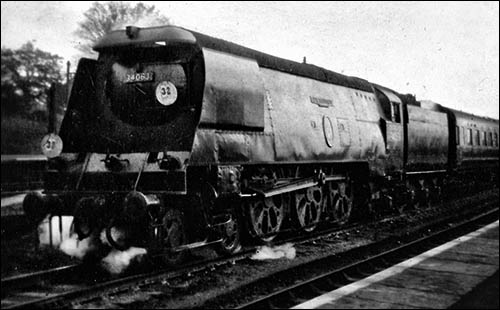Former home of train designer Oliver Bulleid, Llanfyllin
Renowned train designer Oliver Bulleid lived as a child at Penybryn.
Oliver Vaughan Snell Bulleid was born in New Zealand in 1882 to William Bulleid and his wife Marianne (nee Pugh), who had named their house Pen-y-bryn. She belonged to Montgomeryshire’s Pugh and Vaughan families. Her grandfather John had promoted the railway line to Llanfyllin, where he was a churchwarden.
After William died in 1889, Marian and her six children returned to Llanfyllin, where the 1891 census records them living at Penybryn with her mother Mary, a boarder and two servants. The house name isn’t given but it’s thought Mary rented the house named Rhosydd from the Dugdale estate. Rhosydd was built of stone in 1820. Its brick cellar suggests it replaced an earlier house (local brick was much used in Llanfyllin in the 18th century).
Oliver was schooled locally before going to a Scottish boarding school in 1892. After qualifying at a technical school, he lived again in Llanfyllin while waiting to join the Great Northern Railway in Doncaster. He was an army officer in the First World War, managing transport of supplies in France.
 From 1912 Oliver was assistant to Nigel Gresley, designer of the Flying Scotsman and Mallard (holder of the world speed record for steam). Nigel benefited from Oliver’s talent for innovation.
From 1912 Oliver was assistant to Nigel Gresley, designer of the Flying Scotsman and Mallard (holder of the world speed record for steam). Nigel benefited from Oliver’s talent for innovation.
In 1937 Oliver became the Southern Railway’s chief mechanical engineer (CME). His engineering flair quickly shone through, most famously with his express “Pacific”-type steam locomotives with “air smoothed casing” to reduce air resistance. One of them, named after the RAF’s 229 Squadron, is shown in the 1956 photo by Peter Clark.
Oliver’s design of carriage, with distinctive curved sides, was churned out by the hundred for the dense commuter network south of the Thames. In 1949, after the Southern was subsumed into British Railways, Oliver introduced two-level commuter trains, despite Britain’s narrow loading gauge (defined by tunnel and platform clearances). He also introduced diesel locos and controversial “tavern cars” – new carriages decorated like old country pubs!
His final job was as CME of Ireland’s railways from 1951 to 1958, where he experimented with a turf-burning loco. He died in Malta in 1970.
WWith thanks to Pauline Page-Jones, Peter Clark and Sally and John Browne. Sources include ‘Bulleid: Last Giant of Steam’ by Sean Day-Lewis, George Allen & Unwin 1964.
Postcode: SY22 5AP View Location Map
More about Oliver Bulleid’s work – website of the Bulleid Society


